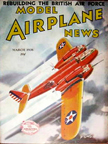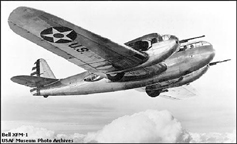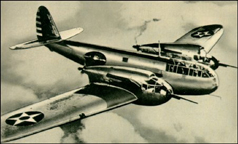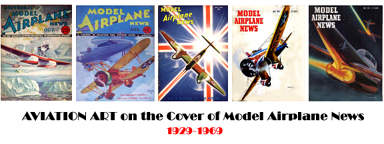March, 1938

Bell YFM-1 "Airacuda"
Model Airplane News Cover Art for March, 1938
by Jo Kotula
Click to Enlarge
The United States Bell YFM-1 Airacuda was the first military aircraft produced by the Bell Aircraft Corporation. Originally designated the "Bell Model 1," the Airacuda first flew on 1 September 1937. The Airacuda was marked by bold design advances and considerable flaws that eventually grounded the plane.
The Airacuda was Bell Aircraft's answer for a "bomber destroyer" aircraft or "a mobile anti-aircraft platform" as well as a "convoy fighter" intended to intercept enemy bombers at distances beyond the range of single-seat fighters. The YFM-1 (Y, service test; F, fighter; M, multiplace) was an innovative design incorporating many features never before seen in a military aircraft, as well as several never seen again. Utilizing a streamlined, "futuristic" design, the Bell Airacuda appeared to be "unlike any other fighters up to that time."
A forward-firing 37mm cannon with an accompanying gunner was mounted in a forward compartment of each of the two engine nacelles. The crew of five included a fire-control officer in the nose who used a Sperry autopilot, a fire control system originally developed for anti-aircraft cannon, and an optical sight to aim the weapons. This crew member could also use a periscope mounted below the nose to monitor the rear and, hopefully, spot enemy fighters coming up in the Airacuda's "blind spot."


Bell YFM-1 "Airacuda"
Click to Enlarge
The Airacuda was plagued with problems from the start. Despite its sleek looks, the Airacuda was heavy and was slower than most bombers. In the event of interception by enemy fighters, the Airacuda was not maneuverable enough to dogfight, while the meager 600 lb bomb load was of little use in the intended fighter-bomber role. Even the centerpiece, main 37 mm cannon armament, were perilous to use. The cannons had a tendency to fill the gun nacelles with smoke whenever fired and, additionally, fears persisted as to how the gunners would escape in an emergency, with the propellers directly behind them. An emergency bailout would have required both propellers to be feathered,though additional provision was made with the use of explosive bolts on the propellers to jettison them in the event of a bailout.
It was another gorgeous flop.
Here is a video of the Bell YFM-1 "Airacuda" in action:
Click Here for more information about the Bell YFM-1 "Airacuda".

Click to go back and select another cover.
Counter for the Entire Site (not just this page..)
Home | About Lindy | Last Week's Reviews | Upcoming Events | 1940s Collecibles
The Guide - Establishments - Travel - Accessories
Music | Links | Photo Gallery | Extras | Contact